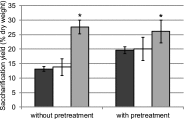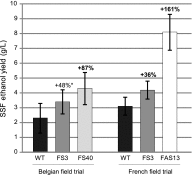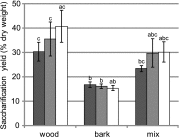Improved saccharification and ethanol yield from field-grown transgenic poplar deficient in cinnamoyl-CoA reductase
- PMID: 24379366
- PMCID: PMC3896177
- DOI: 10.1073/pnas.1321673111
Improved saccharification and ethanol yield from field-grown transgenic poplar deficient in cinnamoyl-CoA reductase
Abstract
Lignin is one of the main factors determining recalcitrance to enzymatic processing of lignocellulosic biomass. Poplars (Populus tremula x Populus alba) down-regulated for cinnamoyl-CoA reductase (CCR), the enzyme catalyzing the first step in the monolignol-specific branch of the lignin biosynthetic pathway, were grown in field trials in Belgium and France under short-rotation coppice culture. Wood samples were classified according to the intensity of the red xylem coloration typically associated with CCR down-regulation. Saccharification assays under different pretreatment conditions (none, two alkaline, and one acid pretreatment) and simultaneous saccharification and fermentation assays showed that wood from the most affected transgenic trees had up to 161% increased ethanol yield. Fermentations of combined material from the complete set of 20-mo-old CCR-down-regulated trees, including bark and less efficiently down-regulated trees, still yielded ∼ 20% more ethanol on a weight basis. However, strong down-regulation of CCR also affected biomass yield. We conclude that CCR down-regulation may become a successful strategy to improve biomass processing if the variability in down-regulation and the yield penalty can be overcome.
Keywords: GM; bioethanol; second-generation bioenergy.
Conflict of interest statement
The authors declare no conflict of interest.
Figures




References
-
- Yuan JS, Tiller KH, Al-Ahmad H, Stewart NR, Stewart CN., Jr Plants to power: Bioenergy to fuel the future. Trends Plant Sci. 2008;13(8):421–429. - PubMed
-
- Solomon BD. Biofuels and sustainability. Ann N Y Acad Sci. 2010;1185:119–134. - PubMed
-
- Vanholme R, et al. Metabolic engineering of novel lignin in biomass crops. New Phytol. 2012;196(4):978–1000. - PubMed
-
- Boerjan W, Ralph J, Baucher M. Lignin biosynthesis. Annu Rev Plant Biol. 2003;54:519–546. - PubMed
Publication types
MeSH terms
Substances
LinkOut - more resources
Full Text Sources
Other Literature Sources
Miscellaneous

